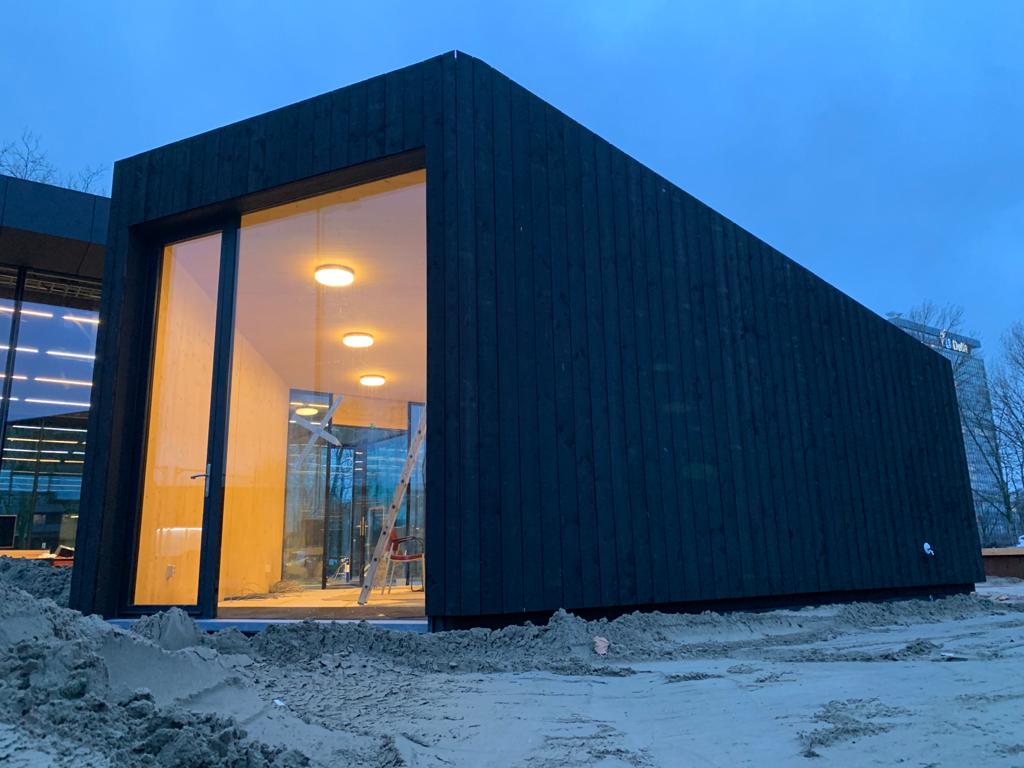
The building is ready: The NoNo House – which stands for no NOx (nitrogen oxides) – on the grounds of The Green Village, a living lab at the TU Delft campus in the Netherlands. Construction, applications and tests at this location are all aimed at reducing nitrogen emissions. The hope is that nitrogen-free construction will be widely adopted. Wherever possible, the building will be nitrogen-neutral or will even reduce nitrogen by absorbing it.
The nitrogen-free house serves as a location to explore solutions for reducing nitrogen emissions in construction. A great deal of valuable knowledge is expected to be gained, Tim Jonathan emphasises. As manager of Operations & Realisation at The Green Village, he is closely involved in the development.
“Its completion was slightly delayed due to Covid, but everything is in place. As far as the construction of it is concerned, it is ready. The building is connected to water, sewage and electricity utilities. It should be up and running this January.”
“First of all, let me explain the principle of The Green Village, where the NoNo House is located. It is a field lab for sustainable innovation. Think of it as a platform that provides parties with support in developing, testing and demonstrating sustainable innovations. Besides facilitating a unique test location, our role is also one of match-making, as in connecting all the necessary parties with each other to bring innovations successfully to the market.”
All aspects play a part
The Green Village is working in a consortium in the NoNo House project together with Mecanoo architects, engineering firm ABT, contractor WAM & Van Duren, installer company Binx, and NL Greenlabel. They all want to play a part in tackling the nitrogen crisis. This came about as a result of recent rulings by the Dutch Council of State. A change of course is called for, because a lot of construction and infrastructure projects have since ground to a halt.
The NoNo House is part of the Co-Creation Centre, which offers space to host events. These might include workshops or presentations with up to 240 participants. Jonathan: “Since we want to use the Co-Creation Centre as flexibly as possible for tests and events, we opted for an open floor plan. Then the toilets, technical installations, pantry and cloak room are housed in an annex, which is the NoNo House.”
Efforts had already been made to work as dust-free as possible during construction. “What else do you have to think about then? Insulation material was taken into account in the design. We used green facades and, in addition, we used as many ways as possible that already exist to limit nitrogen emissions. Take, for example, wood that can absorb nitrogen while it is growing. Alder wood is one option that is suitable for this.”
Water ferns on the roof
“The entire structure is made of Cross Laminated Timber, CLT for short. CLT is a wooden construction, instead of steel or concrete. That makes a huge difference. The advantage is that you can leave it as it is. It doesn’t need a finish, like wallpaper or drywall.”

“Secondly, care was taken during the construction process itself to minimize the amount of nitrogen. This can be done by looking at the number of transport movements and activity on the construction site itself. This concerns excavators, cranes or generators. Using electrical equipment avoids unwanted emissions. Also, most of the piles for the foundation had been used before. We were able to use piles from a nearby project. We only needed four new ones. Not only is that sustainable, it saves on costs as well.”
“Thirdly, nitrogen emissions can be reduced when a building is in use. Preferably neutrally, meaning with no emissions at all, or even negatively, i.e. when nitrogen is absorbed. You can use water ferns as vegetation for a rooftop water feature.”
Nitrogen-free experiments
And, of course, all kinds of experiments are being done to figure out how to keep a building nitrogen-free. Or even reduce the amount of any unwanted emissions. “One of the planned experiments is to coat the facade with yogurt or cottage cheese. Certain lichens that grow well on these may be an indicator of nitrogen concentrations in the air. We can tell this because of the way in which their color changes.”
The funding that stems from The Green Village, is basically courtesy of European funds, Jonathan clarifies. ” This is being done together with TU Delft and several market parties. Apart from that, there are also candidates for a research project. These involve institutes, researchers or governments. There’s a collaboration with the province of South Holland in the case of the NoNo House. That’s because we do a lot for local entrepreneurs. A competition was even organized for this very purpose. This featured a challenge that start-ups could take on if they addressed certain themes. The winners can test their ideas out with us.”
These turned out to be Fairm and The New Makers. They will have twelve months to test and develop their innovative project. The Green Village will provide support for any eventual upscaling. Moreover, the winner will receive €10,000 to build a prototype.
Influx of start-ups
Thanks to its location on the already established Green Village, the NoNo House has an influx of start-ups and other companies that are already active there. On the initial selection of initiators who want to try out their ideas there: “The initiative for the NoNo House comes mainly from Mecanoo (a Dutch architecture company that is renowned mainly owing to its founder Francine Houben, ed.) as a result of the crisis surrounding Lelystad Airport, among others. They are also the ones delivering the first projects. Bio-based materials design company Blue Blocks is going to test out their Maasplaat: Sheet material constructed out of seaweed. How does this work? Just imagine processing the material or it coming into contact with moisture. The New Makers plans to experiment with nitrogen-binding sheet material based on zeolite and titanium dioxide.”
The NoNo House is permanent, whereas its users are temporary. “It provides the basic infrastructure for transitional innovations. For example, an experimental setup will be removed after a year to make way for a new type of test.”
The NoNo House is an extension to the Co-Creation Centre and will house the entrance and facilities for the center. The building has a floor area of approximately sixty square meters and will accommodate plumbing, a small pantry, storage and installation space for utilities. The structure is designed to be modular so that the facade and roof can be used for research projects.

